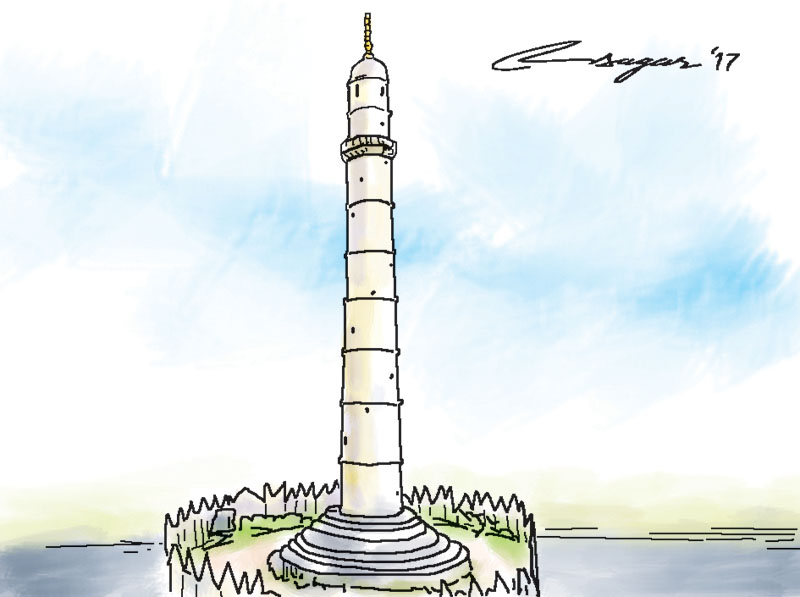Dharahara reconstruction: Recreate the past glory
A new design has been prepared for its reconstruction retaining the damaged Dharahara which should certainly enhance the Khichapokhari surroundings after its construction, and the reconstruction of the Dharahara built by Bhimshen Thapa
Kathmandu has been robbed of one of its identities after one of its tallest landmarks, the Dharahara, came staggering to the ground after the high magnitude earthquake that occurred on the gloomy afternoon of 25th April, 2015. It was constructed by Prime Minister Bhimsen Thapa on the orders of the then queen Lalitatripura Sundari in the year 1825. It remained unharmed by the 1833 earthquake. However, it again collapsed in the 1934 earthquake with only two floors standing from the bottom up. It was in a way miraculously reconstructed within one year by Prime Minister Juddha Shamsher compared to the present post-earthquake reconstruction which is virtually at a standstill.
When it was constructed for the first time, two Dharaharas decorated the Kathmandu skyline. The other was its taller antecedent constructed by Bhimsen Thapa for himself in 1824.This Dharahara was affected in the 1834 earthquake and it was not repaired, because Thapa had to exit from the political arena rather tragically by committing suicide. It was completely razed to the ground in the 1934 earthquake and disappeared from the scene. Kathmandu must have appeared stunningly beautiful after being graced by twin towers like the erstwhile New York with the World Trade Center or the present Kualalumpur with petronas towers. Unfortunately, both the Dharahara towers are no longer there in Nepal.
No other attempts have perhaps been successful towards constructing twin towers during the time of a single individual. In India, Qutb Minar was constructed by Qutbuddin Aibak in 1199. Later, Allauddin Khilji wanted to construct a bigger Qutb Minar but he was not successful because of his death in 1316. As a result, the abandoned tower continues to project a truncated sorry look even now in front of towering Qutb Minar. In Italy in Bologna more than 180 towers mushroomed in the medieval period around the 13th century. Twin towers more, popularly known as Two Towers, Asinelli and Gorisenda had been constructed in this city. These were, however, not constructed by one individual but by two rival families. But the two Dharaharas were constructed incredibly in an unusually short span of two years that too by a single individual Bhimshen Thapa, a rare feat in itself thus warranting its resurrection after the devastating earthquake and its aftermath.
We at times tend to view the erstwhile rather despotic rulers like Bhimshen Thapa with indifference which is natural but in the process some of their good deeds fall on the shadow. Similar is the case of Junga Bahadur. He is portrayed as a cruel ruler who emerged out of the blood pool of the Kot Massacre which can be termed as very brutal, but only he could regain Banke and Bardia after helping the British rulers in the Indian Rebellion of 1857 in India which had been lost following the Sugauli Treaty of 1816.
A new design has been prepared for its reconstruction retaining the damaged Dharahara which should certainly enhance the Khichapokhari surroundings after its construction, and the reconstruction of the Dharahara built by BhimshenThapa in its original place would add beauty manifold to this area. The reconstruction of a single Dharahara was made possible by the Prime Minister Juddha Shamsher in the aftermath of 1934 earthquake. The emulation of Juddha Shamsher in the present times would be a major achievement and spectacular. So attempts should be made towards the reconstruction of both the Dharaharas to recreate the past glory of the Nepali skyline.
Unfortunately, the Government does not realize the unusual power of architecture, the mother of all arts and hence does not accord it its due priority. In fact, the architecture and the architects in Nepal are generally ignored despite having such an illustrious history. The architecture of Nepal was lauded as something seen nowhere by none other than the renowned Chinese traveler Wang Huen Che in the seventh century. In the thirteenth century, Nepali architect Arniko constructed the white pagoda which still continues to dominate the Beijing skyline at a time when China has begun to exercise its supremacy all around the world. The burning example of the humiliation meted to them is the compulsory legal provision made for the architects to register in all the municipalities despite being a member of the Nepal Engineering Council while its counterparts, the doctors and the lawyers, get off scot-free after displaying the membership of the concerned councils. A case has been filed in the court because of this injustice unnecessarily dumped on the architects. The other is the nonchalance shown by the Government to establish the Nepali Council of Architects while the majority of the SAARC countries proudly display them.
Such reconstruction is not anything new in Nepal. The Chaslin Mandap of Bhaktapur was leveled to the ground by the 1934 earthquake and with the help of the photograph taken in the year 1885 by French Traveler Scholar Gustave Le Bon, the octagonal pavilion was reconstructed in 1990 after a lapse of 56 years. Bhimshen Thapa’s Dharahara may also again stage a comeback like the mythic bird phoenix is said to have done from the ashes, if given a chance.






